2009년 11월 26일 목요일
LED 마술의자
2009년 11월 7일 토요일
Linking mugs


I can't seem to find a way to describe these "link mugs" without venturing into uncomfortable sexual metaphors, so I'll just let the photos speak for themselves. So you can, you know, carry a bunch of them at once. [via Slippery Brick]
Read more | Permalink | Comments | Read more articles in Gadgets | Digg this!five Cyclops watches by Mr Jones Watches to be won

Dezeen have teamed up with Mr Jones Watches to give away five Cyclops watches. (more…)
New Duravit PuraVida Line
암튼 아래 디자인은 모르는 사람이 봐도 단순한 형태가 멋지다..
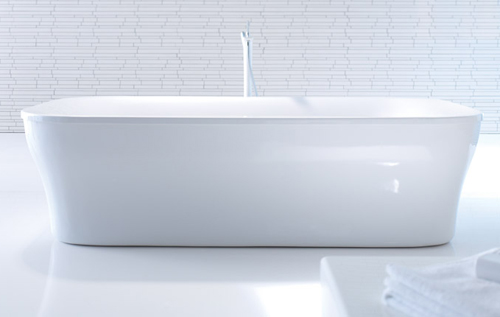
Duravit collaborates with Phoenix Design and fittings manufacturer Hansgrohe to launch PuraVida, a new line of bathroom furniture that makes me drool. In fact, I think when they were designing it, they tested to see how high it was on the drool scale, and — yep! a 10.
You can always count on Duravit for modern, clean lines and elegant bathroom furniture. This collection has more flowing curvy lines than their other collections. The pieces are available in deep red or classy black paired with high-gloss white, ebony or aluminium.
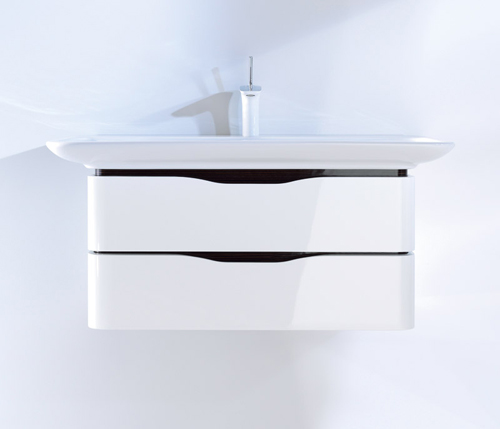
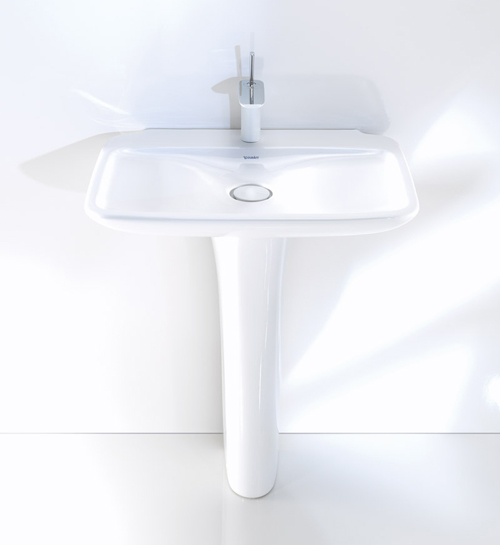
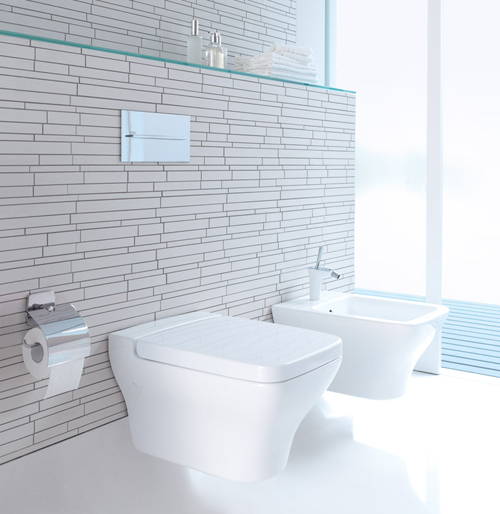
MIT's AIDA project

the AIDA project (affective, intelligent driving agent) is a driving navigation system with a robotic interface
that goes far beyond turn by turn navigation. the project is a collaboration between, volkswagen of america
and the massachusetts institute of technology (SENSEable city lab and personal robots group of media lab).
the navigation system stores information about the city, the driver’s routine and a number of other sources.
it combines this with road conditions, traffic and other data to create an ultra intelligent driving assistant.
by knowing more, AIDA can behave more intelligently. the platform even predicts your destination
notifying you of any incidents along the way and proposing alternative routes. one of the best
demonstrations of AIDA’s intelligence is that it will include a trip to the gas station in your route if
your tank is running low.
http://senseable.mit.edu/aida

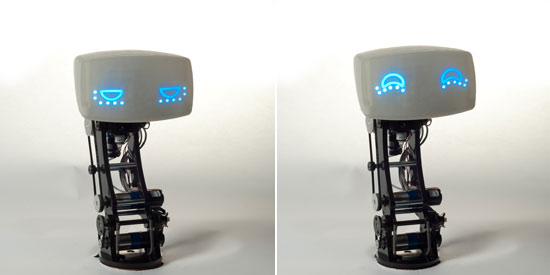


Industrial Design Portfolio Advice: Back to Basics
디자이너를 위한 포트폴리오 에 관한 조언...
기본으로 돌아가라....

For an Industrial Designer a design portfolio is an essential element in getting employment. There are hundreds upon hundreds of ways that you can construct your portfolio. You could create it in Flash, on the Web, as a hard copy, as a movie – the possibilities are endless if you put your mind to it.
In this article I will be talking about the basics of design portfolio creation that will allow you to create an excellent portfolio, no matter what medium you decide to choose.
In the creation of a design portfolio there are many considerations you must take into account throughout the building of the portfolio. However the overall process can be broken down into 5 main steps.
1. Plan, Plan & Plan.
2. Collect & Curate Content.
3. Design & Layout.
4. Review.
5. Revisit & Refine.
Plan, Plan & Plan

Planning is an important part of creating your portfolio. Since your portfolio is representing you and your work to people who, in many cases, you have never met then it is very important that it is well thought out and coherent. A portfolio should not be thrown together in a rush – which so often happens when that elusive job opportunity pops up.
You can avoid the rush by setting aside time to properly prepare your portfolio before your start searching for any form of employment. If you are a student, start making every project you create portfolio worthy as soon as possible and take time to consider how each one will fit into your portfolio. I know many people probably tell you this, but it is very very true and it will make life much easier come graduation.
The planning stage is essentially about clarifying a few things for yourself. This clarification will guide your decisions as you create your portfolio.
Portfolio Aim - Who is the portfolio for?
A portfolio is usually meant for one of two particular types of people 1. Potential Employers or 2. Potential Clients.
Although a portfolio for either of these types of people may be quite similar, it is an important consideration to keep in mind as these people will be looking for slightly different things in your portfolio.
Purpose of the Portfolio
Always keep in mind the main purpose of the portfolio – to effectively communicate and showcase you and your amazing design work. This affects many aspects of the portfolio, the main one being the design. The design of any portfolio should be understated, and allow your amazing skills and design work to shine.
Tip: A portfolio is a container for your design work, but it is a container that can be tailored to complement the work. Bottom Line – You don’t want the container to be better than the work inside.
Key Questions
Here are some other key questions to think about during the planning stage.
- How will you or how do you want to guide a prospective employer or client through your body of design work?
- How will you convey the right information, without undersupplying or over-supplying information?
- How much do you want to spend? – don’t spend the earth on your portfolio, but don’t be cheap either (spending might include things like printing & binding).
- What is the deadline for having your portfolio ready to present or send to someone?
- How many pieces do you need to show? This might be specified as a requirement in a job application or by a potential client, then again it may not.
- Does the portfolio need to display a broad set of skills or a very particular set of skills?
Tip: Go for Quality over Quantity.
Collect & Curate Content

In a portfolio, like on the web, Content is King. The design work that is actually contained within your portfolio is very important. Your portfolio is (or should be) telling someone a lot about you and what type of designer you are. It needs to be telling them exactly what they want or need to know, especially when you are not there with your portfolio – which is often the case.
Dependant on some of the answers to the questions mentioned in the planning stage you will have a tentative idea of some of the content that you will be putting into your portfolio.
At this stage it is important to gather as many of your relevant projects and design work as you can so you can begin the arduous task of sifting through and deciding what makes it into your portfolio and what does not. Note the use of the words Arduous and Curate. This stage is always the hardest part of constructing any portfolio, thus it is arduous. Curating your work to ‘tell a story’ and guide the viewer through it is very important so that your portfolio presents a coherent message about you and your design work.
Tip: Try out different combinations of your design projects for your folio, spend time considering each combination. Curate it until you find a flow through the work – flow is the point when it seems to fit together and tell a cohesive story.
Key Questions
- What does this particular combination of my design projects say about me and my design work?
- Does it communicate what the target audience might want to see? I use the word audience because your portfolio may be reviewed by more than one person – sometime an entire design team may see your portfolio.
- How many pieces of design work do you need to show to tell your ’story’? I would personally put in 6 – 10 pieces dependant on the work I have recently completed and the prospective job/client. Amount of pieces is always a key area of contention among designers, so go with what you feel is suitable.
Tip: If in doubt, take it out.
Design & Layout

The design of your portfolio needs to thought through quite carefully. The design and layout of a portfolio must do two things:
- Allow your work to shine ,and thus by extension make you shine. Do not create a portfolio that looks better than the work inside!
- It should make you look professional.
Avoid creating something that distracts from the work contained inside. A great example of portfolios that have a multitude of distractions are Flash based folios.
Designers get over excited by the many things they can do in Adobe (formerly Macromedia) Flash – animations, crazy unintelligible menus etc… These flashy bits cause it to take longer to load and serve no useful purpose other than to distract and annoy the viewer.
Unless you are actually a flash designer, then people are not going to look at your folio to see the amazing flash skills you have, they are looking at the actual work contained within. These bells and whistles will severely annoy the extremely busy people (company owners, studio heads or the underpaid HR people) who have the unfortunate job of having to sift through hundreds of portfolios. So if they are in Flash, take a million years to load even on their high speed connection, and they cannot quickly and easily navigate them then you will probably be passed by.
This also applies to portfolios in other mediums that have terrible layouts that distract (overly flashy graphics and colours), are badly designed (there are a few too many badly designed websites that showcase design work) and are not easy to figure out (sure get creative with your portfolio presentation, but if someone has to read a manual to figure it out, forget it they have already moved past yours!). Make your portfolio clear and simple. It MUST communicate, not confuse.
Remember simplicity does’t mean you don’t take time to put some effort into designing your portfolio or that you don’t explain yourself. Simplicity means you create a considered and appropriate design, and then take away all the superfluous crap that is not truly needed to communicate you and your work.
Multiple forms of media
These days it is also common for people to have a portfolio across a variety of media, the most basic and obvious being print and web. Don’t put all the effort into one and neglect the other.
Make sure that no matter how many mediums you are putting it into, that the portfolio design is as consistent across the mediums or that they complement each other as much as possible*. These days those looking at portfolios are likely to see a web and a print one, its nice if they obviously have a consistent look and feel so that the portfolios speak to them in a similar way about the work inside.
*Note: This is of course not always possible when using a service like Coroflot. But the great thing is that they have already provided a portfolio container that does a lot of things that your portfolio container needs to – its understated, clear, simple, sort of elegant. But remember it doesn’t do everything.It is just a cookie cutter approach to allow you to get up and running quickly at no cost.
Tip: If you are not skilled in graphic design, page layout, web design or what ever medium you want to use, then find someone who is to help you with the design and layout of your portfolio in that medium.
Cost
Cost is another major point of contention among designers when discussing portfolios, so I will be brief.
Spend what you think is reasonable and what you can afford. If you cannot afford a lot use that designer brain you have and treat it like a design problem, come up with a creative solution that meets all the requirements previously talked about. Don’t go overboard (your portfolio doesn’t need to be gold-plated or hosted on a Nitro Mediatemple hosting package), but don’t be stingy (make it look professional, shitty photocopied pages don’t look professional!).
Key Questions
When you execute the design of your portfolio the types of questions you should ask yourself are the same questions you should ask when you are designing a product.
- Does this actually need to be there? (e.g.: a little hovering thing next to the cursor in a Flash portfolio)
- What reason is there for it to exist?
- Does it serve a purpose? Or is it just a bell & whistle designed to distract?
- Does it actually look good?
- Does it communicate?
- Is it an effective and appropriate design or design element?
Review

Get someone to review your portfolio. You should take your it and show it to your peers, and anyone else who you think will provide you with excellent feedback on your portfolio.
Your peers might include (dependant on your situation) fellow students, lecturers, work colleagues, friends or family. Anyone else could include people you are aquatinted with in your part of the design industry.
For example you might, through your networking (which is an essential for any designer), be aquatinted with the senior designer at a local design studio (if applying at that particular studio then be careful about asking for a portfolio review, personally I might find someone else to ask for a review who knows what that studio is like).
Bounce this acquaintance an email which politely and courteously asks them if they will take some time to sit down and talk with you about your portfolio OR if they will review it via email/phone.
DO NOT attach a digital copy your portfolio to this email, the reasons for this are two fold.
They do not want any more attachments clogging up their email inbox – especially if they decide they do not want to or have the time to review your portfolio.
The second reason is that if possible you want to talk with them in person. If you were to send them your portfolio in the request email they are more likely to do a short, possibly unconsidered review (this is not always the case, but for busy people you could visit it person it usually is) via email.
Having your portfolio reviewed in person is excellent as it allows you to do several things at once.
1. If the person is an acquaintance then you are provided with a chance develop and further the relationship.
2. You will also get a more in-depth review because the person will in be forced to actually take the time to review and provide feedback directly.
3. You will also pick up on more subtle reactions - often facial reactions, but also changes intone of voice and the particular words used – that you would NEVER be picked up via email or over the phone.
4. Its more personal.
Getting a Face to Face Review
Getting a face to face with senior design professional can be difficult. As they are of course busy and they probably receive similar requests more often that you can imagine. Sequence things should occur – email, potentially a phone call, possibly a follow up email, then if everything goes well a meeting.
GOLDEN RULE : DO NOT be rude, always be extremely courteous and polite. They are doing you a favour.
Be bold and direct – ask for what you want, in other words don’t dilly dally around making small talk about the weather.
When writing an email, if you have met them previously be casual polite (i.e you could open the email with ‘Hi John’). If you do not know them and this is first contact be proper and polite (i.e. ‘Dear John’) and introduce yourself (i.e ‘My name is Jane Jones I am writing to you because……’).
Keep the emails short, punchy and too the point.
Ask for 1 hour. You may not get it, you may only get 30mins or 45mins. But always ask because you might. An hour is a good amount of time as it allows time for the person to be late, for the review and a bit of chit chat and a coffee. If they are willing only to give you say 15 mins, then politely decline and explain why you need at least 30mins to 1 hour. If they still won’t let up then move on and find someone else to ask.
Pick some dates and times that suit you and suggest them to the person, ask if any of these dates or time suit them and negotiate from there. Be flexible they are busier than you are.
If you want to visit the studio, ask to meet them there, but try to make sure you have the meeting a nearby quiet coffee shop. The reason for this is that it takes them out of their work environment where they may be easily distracted by work things. Eg: if other staff know its not a client meeting they may ask for opinions from this person – which will eat into your meeting time.
Once you have had the meeting and the portfolio review follow up by sending a thank you email.
Tip: ALWAYS be courteous and polite about criticism. DO NOT burn bridges (translation: don’t piss them off) you never know what you might might happen in the future.
Key Questions
Here are a few basic starting questions to ask anyone (or even yourself) who is reviewing your portfolio.
- These are the skills I want to convey, INSERT SKILLS HERE (e.g., Excellent attention to detail), do you feel that my portfolio conveys this?
- Does this all make sense to you without me having to explain it? If I wasn’t here would these projects make sense to you?
- If no (to the above question), then how do you think I could make sure they are conveyed effectively?
- Does the Design of my portfolio compliment the work inside or does it over shadow it?
- The purpose of this particular portfolio is XXXX do you think that it is suitable for this purpose?
Revisit & Refine

There are several likely scenarios after you have had a few people review your portfolio for you (scenarios 2 and 3 are probably most likely, and ideal).
1. You need to go all the way back and start from scratch – hopefully not, but it could be the case.
2. Your need to review the overall portfolio and then refine it.
3. A few small areas need fine tuning and refining.
4. That senior designer that reviewed it thought it was so good that he offered you employment and you no longer need to use the portfolio for that other job you were going for (You never know who might see your portfolio and offer you employment!).
Wrap Up
Keep in mind you will need to revisit, update and refine your portfolio regularly. I would say it is ideal to revisit every 3 – 6 months, but this is dependant on your situation and it might occur at different times for different reasons.
Reasons could be:
- You create some new work you feel needs to be in your portfolio.
- You have a particular job you want to apply for, so you revise and update to match the requirements of that job.
- You want to change jobs, are retrenched or are fired from your job.
- You get sick of the portfolio and design you have, so you start from scratch.
Tip: Look after your portfolio and keep it safe and dry, don’t show a portfolio around that has coffee stains all over, is ripped or looks like it has been for a trip through a sewer.
Good luck with your portfolio and I hope that some of the tips and advice above helps you create one that you will be proud to show around, but more importantly will get you employment.
Additional Resources
While I hope I have covered some of the most important aspects of portfolio creation in this article, not everything can be fitted in. Here are a few additional resources that might help you create an excellent portfolio.
Online Folio Solutions Series – A review series written last year on Design Droplets about various online portfolio hosting solutions.
Why You Should Start Your Portfolio Now – As always, great advice for design students over at Core77.
Advanced Portfolio Tips - Now you have some basics down, why now get into the advanced stuff?
Creating A Successful Online Portfolio - Taking your portfolio online, then be sure to read this one from Smashing Magazine. It also covers some nitty gritty of portfolio creation.
Please take time to leave your thoughts or feedback. Got some tips of your own? Or maybe a question? The comments section is waiting below for you.
"Living With" product review: Knoll's Generation chair
KNOLL 의 새로운 의자 디자인에 관한 이야기..
Remember the hot girl (or guy) in your high school? If they had a sibling, that sibling was almost never hot, and didn't try to be; they realized the incumbent had the hot thing locked down, so they went in a different direction. Siblings of the hot were really witty, and told great stories, and knew where to get booze for the party, and in general were more fun to hang around with.
That's basically Knoll's Generation chair. With competition like the Aeron and the Embody, the Generation strives to do the things those chairs cannot, and succeeds at them. Whether or not those things are things you desire in a chair depends largely on how you sit, or don't sit.

We spent every day for just over a month testing out the Generation, and here are our findings.
Overview:
The first thing you notice about the Generation is its matrix-like backrest, made from high-performance elastomer. It bends and flexes in varying degrees according to the location and size of the carefully-placed perforations. There is a pleasing but not excessive amount of give, well-calculated enough that it makes you feel you're sitting in something expensive.


The second thing you notice is the armrest supports, or rather their absence; instead of coming straight down from the armrests, they wrap around to the back of the chair, meaning you can sit in this chair completely sideways, leaning against the backrest with your side, and there's plenty of room for your legs under the armrest. Despite this added feature, the armrests still provide good support and are easily height-adjustable. It's easy to get them into just the right position with a minimum of fiddling.

The seat bottom is predominantly flat and pan-shaped and accommodates this sideways posture; the entire periphery of the seat bottom actually flexes downwards when pressure is applied to it, curling it into an impromptu and supportive lip.

But the great magic trick of this chair is the top of the seatback. The matrix has been designed in such a way that it bends back upon itself when pressure is applied to it, allowing for extreme lean-back stretching, an armrest when you turn to speak to someone behind or to the side of you, and a comfortable headrest when you slouch down in the chair. I cannot say enough good things about this feature, and I often activated it for its own sake. It actually makes the chair fun to sit in, though fun isn't something we often equate with office furniture.

I should point out that the flexibility in this chair does not come from flimsiness; the chair can look deceptively flimsy in some of the smaller press photos, and when seeing and sitting in the real deal I was surprised to find it sturdy and well-built. The flexibility, in short, comes from careful and thoughtful engineering, not thin plastic.
Actual Usage
The personal, long-term appeal of the Generation will depend on how you sit. I work from home and spend much of my days and nights at the desk-chair-laptop combo, doing work during daylight hours and lounging and movie watching in the same location at night. During work, my fingers always need to be on the keyboard and mouse--I'll rarely, say, read a PDF for more than 30 seconds and not need to be typing something from it--so during work hours I mostly sit in a normal, frontward facing position, in various states of recline, and do not have the opportunity to make use of the Generation's 360 seating possibilities. It's not easy to type while sitting sideways on it, for instance; that feature is probably intended more for when you're conversing with co-workers, which I do not have. The Generation chair is designed for offices that have more of a social-interactive nature to them.
For me as a solitary worker, I found the Generation a Godsend mostly at night, or during leisure time when I had no need to type, and I'd happily sit in it sideways--both leaning sideways against the backrest, or leaning slightly back, throwing my legs over one armrest and adjusting the other to support my lower back, although the edge of it cutting into your back doesn't enable this latter position for as long as the former position. I also discovered you can turn the chair around completely, Rog-from-What's-Happening-style, and the sensation of having the front of your body supported by this mesh matrix is both unusual and comfortable in a very novel way. (In this position all I'd need is a masseuse behind me and I'd be in heaven.) This is an absolutely fantastic chair to watch movies in.
Problems and Criticisms
I only had two minor gripes with the chair. The first was with the material chosen for the backrest; it has a certain amount of "tack," or friction, to it, and often when sitting in the chair and leaning back or shifting slightly, the backrest surface would pull my shirt up in the region of the lower back. If I was wearing a shirt that was tucked in, I'd need to readjust it every time I stood.
The second is the pan-shaped seat bottom, filled with what feels like dense foam. Having been spoiled by Aerons, Embodys and the like, I was not used to the "dead spots" you feel when sitting in the same position on a firm foam surface for long hours. It requires you to move to get the circulation going in that particular spot, rather like in an airplane seat. But I feel compelled to point out that this is no different than any other chair with a foam seat, and I understand, from a design perspective, that the flat shape is required to enable sideways seating (try sitting sideways on the Aeron, for instance, and the rim of the seat support will bite into your lower thigh). Whether or not you consider the trade-off worth it will depend largely on how much you will shift in the chair and use its manifold positional possibilities.
Conclusion
The sturdy, flexible-in-multiple-ways Generation is not like any other chair I've sat in, as it truly does let you "Sit how you want," which is the chair's catch-phrase. If you work in an open office and have the opportunity or need to frequently interact with those around you, this chair will probably suit you well, and fidgety change junkies will feel like the Generation has dropped out of the sky. Constantly forward-facing, solitary workers will want to give it an extended test-sit first.
Video of the Design Process

The Generation was designed in collaboration with New-Zealand-based Formway Design, and you can check out a video explaining the design process here.
Designer Salary Survey: The results are in!
CORE 77에서 조사한 디자이너 연봉에 대한 리서치..
결과만으로보면 돈 많이 버는 분야는 디자인경영이랑 인터랙션 디자인이네..
우리나라에서도 조사하면 아래와 같을까?

The numbers are in, and they are both great and terrible. Coroflot's Designer Salary Survey, now in its ninth year (true!), broke the 5000 response barrier this time around, with strong showings from every design field that calls the site home. The findings are a combination of expected and astonishing.
First, the expected:

Salaries took a tumble this year, almost across the board: the Design Management and Interaction Design fields in particular saw their meteoric 3-year rise come to a sharp and dramatic end, though they're still the highest paid among the eight fields covered. Other disciplines saw gentler declines, with the peculiar exception of Fashion and Apparel, which bucked the downward trend in a big way, showing a nearly US$3,000 increase over last year. Fashion also bucked the experience trend, with mid-level designers in the field out-earning their more venerable counterparts:

Graphic and Interior designers continue to languish at the bottom of the pay scale, and those very few web designers who've been at it since the beginning (Mosaic, Hotbot, blinky text...ah the mid-90s) are making an absolute killing.
Here's another noteworthy shift from last year:

Corporate design studios are losing their dominance. While last year's survey showed more than 60% of respondents working in-house in every field but web design, this year flips that around: all but two fields saw the in-house fraction drop below 60%, with the Freelance and Consultancy categories taking up the slack. The temping of design, it appears, accelerates during dark financial days.
This is just scratching the surface though. For lots more analysis, including regional and international comparisons, salaries by job title, and the influence of education on design salaries, plus a customizable database of all Survey results, go to the 2009 Salary Survey Results page on Coroflot. We've broken it down for you into The Six New Realities of Creative Work, and you know you want to read about those.
>>Read the full analysis and see the entire 2009 data set here.
(more...)
radio with motion based ui
이렇게 간단하게 실현해 냈네..
아이디어가 떠오르면 무조건 먼저 질러야해..^^
il-gu cha: R1 radio
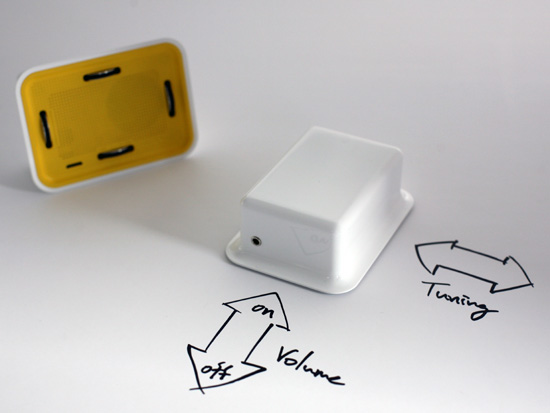
tuning is done by moving the radio from left to right and volume is controlled by rolling the radio forward and backward
R1 radio by il-gu cha is an analog radio which requires one to tune the radio by physically
rolling it on a surface. studying how people manipulate rather than bury their interactions
with a product, the radio brings about a new kind of behavior between itself and the user.
by using a bevel gear system wheel structure, one can control the radio through
physical movement. the R1 allows users to turn the gadget on or off, and control volume
and tuning simply by physically rolling the radio forward, backward and sideways.
you can view a video of how the R1 functions here.
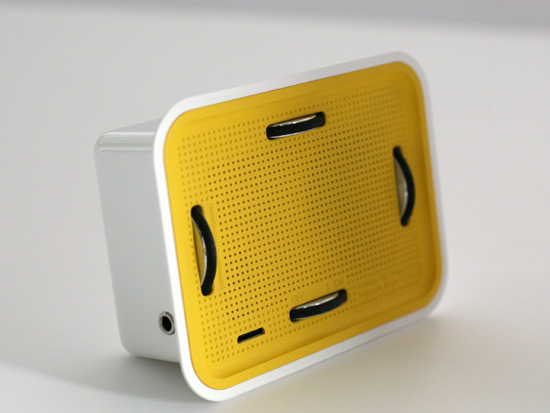
the wheel structure and speaker on the underside of the radio
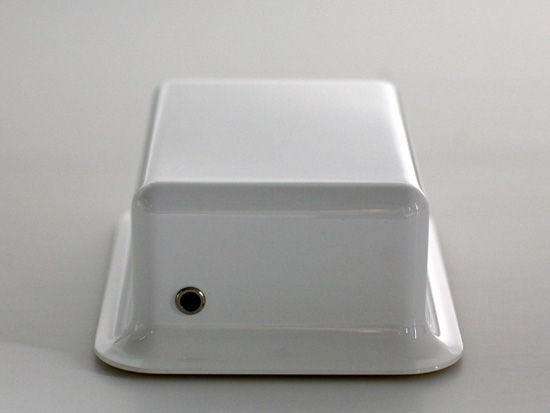
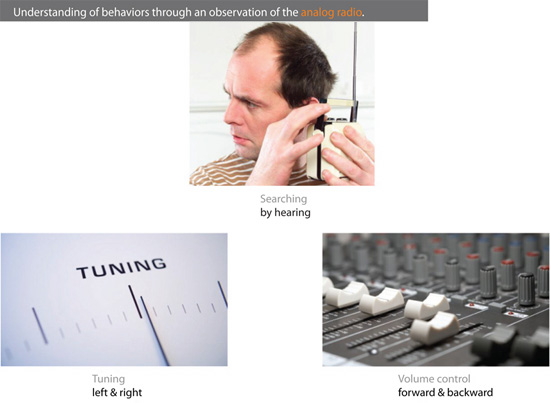
lukas koh: t-issue
휴지를 쓰는 만큼 숲의 나무는 점점 줄어드는 것을 표현한 휴지박스..
하고 싶은 말을 확실히 보여주는 디자인..
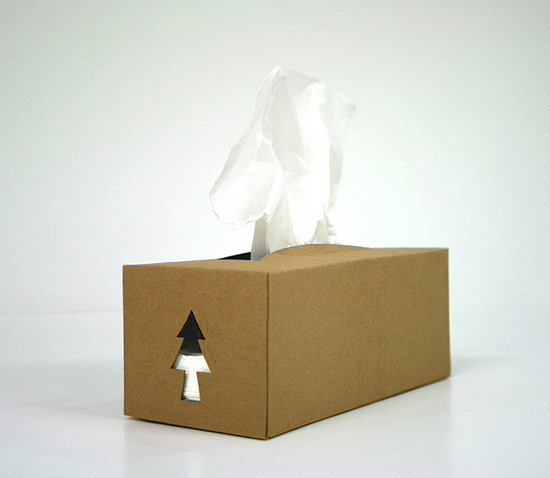
t-issue by lukas koh
for his design 't-issue' korean designer lukas koh plays on an ordinary tissue box,
translating it into an environmentally conscious object. 't-issue' is made
of recycled paper, with the glue which connect the sides made out of natural rubber.
through the tree shaped hole on the side, you can see how much tissue you are using
and how much is remaining in the box. 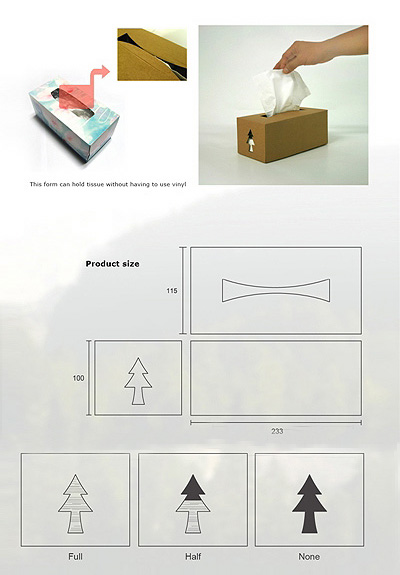
naoto fukasawa: limited edition kaga wall clock
참 단순한데 멋져보이는건 왜일까?
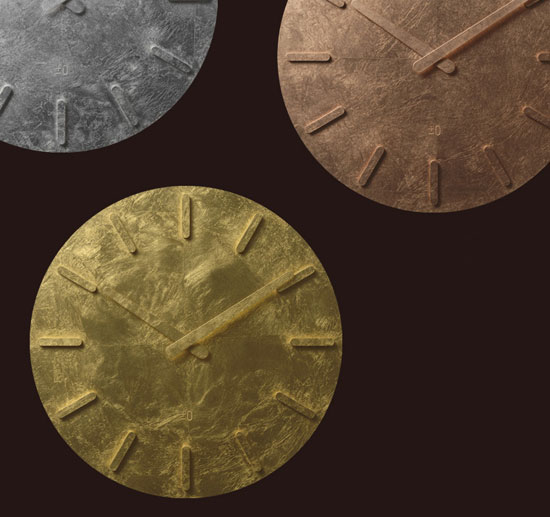
limited edition of kaga wall clocks by naoto fukasawa
naoto fukasawa has created a limited edition of kaga wall clocks for plus minus zero's
flagship store in aoyama. for these special versions fukasawa has used the ancient
tradition of gold leaf, in japan it is now only manufactured in kanazawa city, thus called
'kanazawa leaf' of 'kaga leaf' (kaga is the old name of kanzawa). the simple clock with
no glass or secondhand consists of hour and minute hands which protrude from the surface.
the clocks available in gold, silver and copper are exclusively available at plus minus
aoyama's store or through the website for japanese domestic customers.
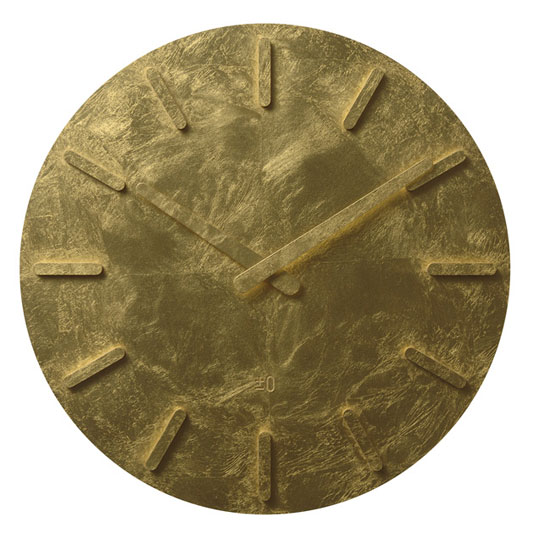
kaga wall clock - gold leaf
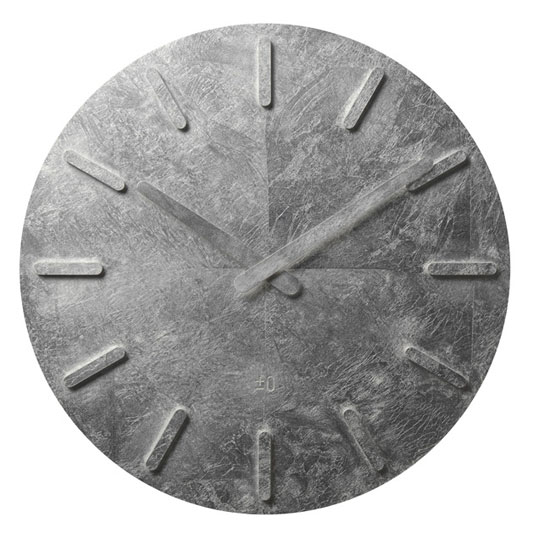
kaga wall clock - silver leaf
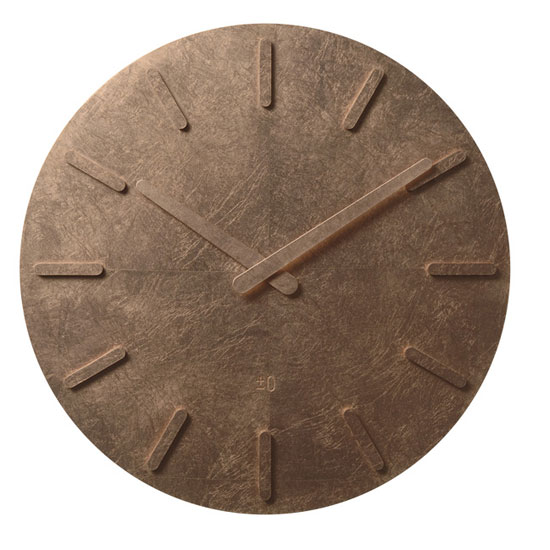
kaga wall clock - copper leaf
2009년 11월 2일 월요일
2009년 11월 1일 일요일
think outside the parking box competition
간단한 아이디어 인데도 이렇게 풀어내니 괜찮네....

'trace' by mario lemos from switzerland, is one of the 66 shortlisted entries from our
from our recent designboom competition 'think outside the parking box' in collaboration
with nissan.
the concept of the parking project is based on the functionality of sundials which indicates
the time according to the position of the sun. trace uses the same system to delineate a
parking space through the use of aluminum poles. meant for parking spaces in sunny places,
the poles are oriented in the direction of sunrise and sunset(wet-east), that reduces or enlarges
the parking space according to time. on sunny days this concept is purely graphical.
the simplicity of the poles become a sculpture, a work of art in a desolate place such as an
urban parking lot. at night, the shadows of the posts are lost in space.








